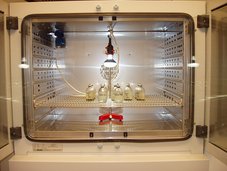



Enrichment and Isolation of Novel Microorganisms
We specialize in the enrichment, isolation, and cultivation of novel microorganisms (bacteria and archaea) from extreme environments, including desert soils, permafrost deposits, and deep sediments and rocks. These fundamental microbiological studies are regularly conducted on newly obtained samples. In addition to aerobic cultivation on agar plates, we employ specialized methods for the enrichment and cultivation of anaerobic microorganisms, such as methanogenic archaea from permafrost habitats and the deep biosphere. All newly isolated strains are systematically characterized and described, ensuring that their properties and ecological significance are documented and made available to the scientific community for further research. The GFZ hosts a unique strain collection containing more than 400 strains of extremophilic microorganisms, providing an invaluable resource for future studies.
Instruments:
- Autoclaves
- Sterile workbenches
- Anaerobic workbenches
- Incubators for cold and warm cultivation
- Gas chromatograph for CO₂ and CH₄ analysis
- Picarro for N2O/CH4/CO2/NH3/H20 analysis
- Centrifuges
- Fluorescence microscopes, including ApoTome
- “Widdel” flasks and gassing systems
- Agar shake applications
- Applikon Chemostat

Growth Experiments and Stress Tests
To further characterize microorganisms, growth experiments are conducted under various conditions to determine cardinal temperatures and identify optimal growth parameters concerning pH, salinity, and substrate utilization. In the context of our research on the distribution and diversity of microorganisms in extreme habitats, stress tests are performed under defined environmental conditions, including extreme temperatures and pressures, desiccation, and high radiation exposure (UV and ionizing radiation). These investigations provide insights into microbial adaptation mechanisms and resilience. Moreover, they help define the limits of microbial life on Earth and assess the potential for survival under extraterrestrial conditions, such as those on Mars.
Instruments:
- Environmental simulation chambers
- Permafrost microcosm
- High-pressure thermal gradient block
- UV radiation cabinet
- Additional laboratory equipment (see Enrichment and Isolation section)
High pressure cultivation
Subsurface organisms are exposed not just to high hydrostatic pressure but also exceedingly high gas concentrations, given the increase in solubility at increasing pressure. So in order to recreate true subsurface in-situ conditions it is important carry out experiments at high pressure and high gas saturation. The section has a custom-built high-pressure thermal gradient block that allows simultaneuous incubation at 15 different temperatures (any gradient between -5°C to 130°C) and 3 different pressures of up to 50 MPa.
As part of the ERC Synergy Project, additional high pressure incubators that allow for manipulation of the gas concentration and composition during incubation, as well as subsampling under pressure and flow-through experiments are currently under construction.